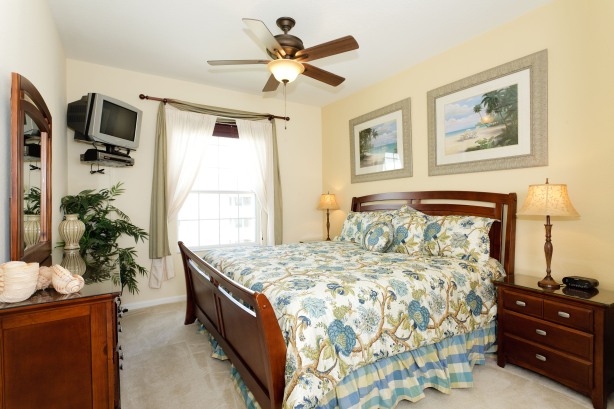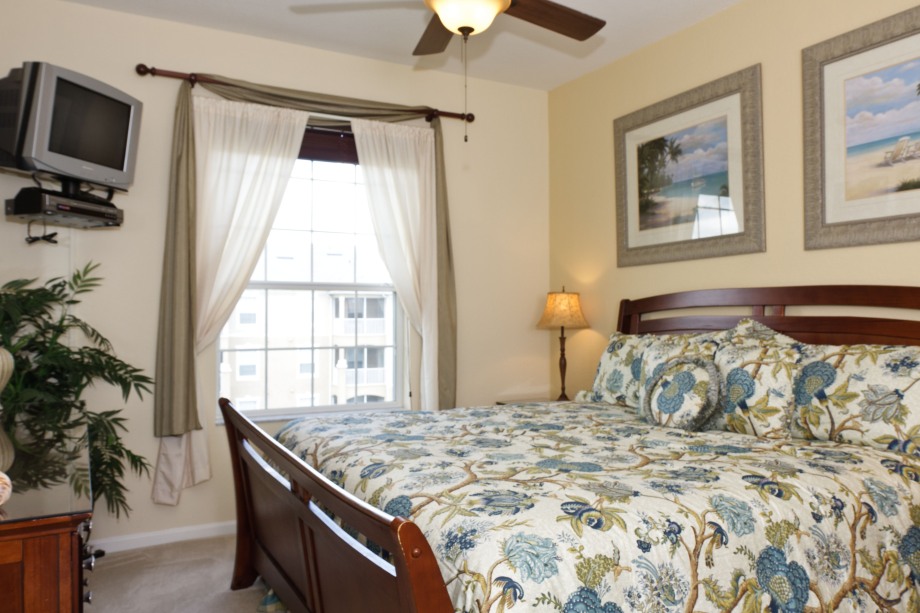Well just yesterday I had the opportunity to test it out first hand using a 5D and 40D. Here’s the set-up: I was shooting a bedroom with the 5D. I had it on a tripod to make sure I was shooting from the same position when I switched to the 40D. I was using a 17-40mm f/4 L on the 5D and a 17-55 f/2.8 on the 40D. Below is the shot on the 5D. I thought I had it racked to 17mm but it was actually 19mm; but hey, I’m not gonna cry over 2mm!
Next, I switched to the 40D and dialed in the same exact settings.
You can see how dramatic the difference is even without the 2mm discrepancy. I knew that a 17mm on a cropped sensor lens is about 24mm (1.6 x 17 = 27.2) so I put the 5D back on the tripod and set it to about 24mm to compare.
It’s pretty close I think (remember I’m off by 2-3mm). This is just another illustration of the difference between full frame and cropped sensor cameras. It’ not a bad thing or a good thing; just something to be aware of. With the knowledge you can take advantage of either a full frame of an APS-C sensor depending on what type of shooting you do.
I want to take a few moments to share a couple of related stories. First, a photographer friend of mine has a 35mm 1.4 and he wants the 24mm 1.4 to get a wider focal length. For an extra 11mm, I would take a step back when composing and save the $1700.
I was reading a blog about the 17-55mm f/2.8 and it said the lens gives you a wide focal length. I commented that it’s comparable to the 24-70mm f/2.8 but at a lower price point and with the added benefit of image stabilization (IS). The writer wrote back and said because it is an EF-S lens that the true focal length is 17-55. I referred him to some supporting documentation and never heard back. Just goes to show that just because it’s in a review or a blog (even this one) doesn’t mean it’s gospel.
Lastly, I’ve been asked if a full frame camera will deliver sharper images than an APS-C sized sensor. Sharpness is a function of the lens and your camera settings (shutter speed, focus drive etc.). The weakest part of a lens is typically the edges. Now imagine a circle inside a square. The square is your sensor and the circle is the image coming from your lens. Because the square is larger than your circle (full frame) you are going to see every part of the lens. This is why most lenses produce vignetting on full frame cameras but not cropped sensors.
Now imagine a square inside a circle. Because the square is smaller (cropped sensor) you will not see the edges of the circle. So in general lenses perform better on cropped sensor cameras; but that’s not due to some design flaw in full frame cameras. It’s just the nature of the beast. The better the lens, the fewer the distortions. Again, I am generalizing and simplifying here. Every lens generally performs better when stopped down from its maximum aperture. You really have to research a camera and lens and test drive it yourself.
Well let me leave you with the final edited image of that bedroom.






